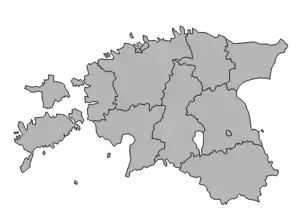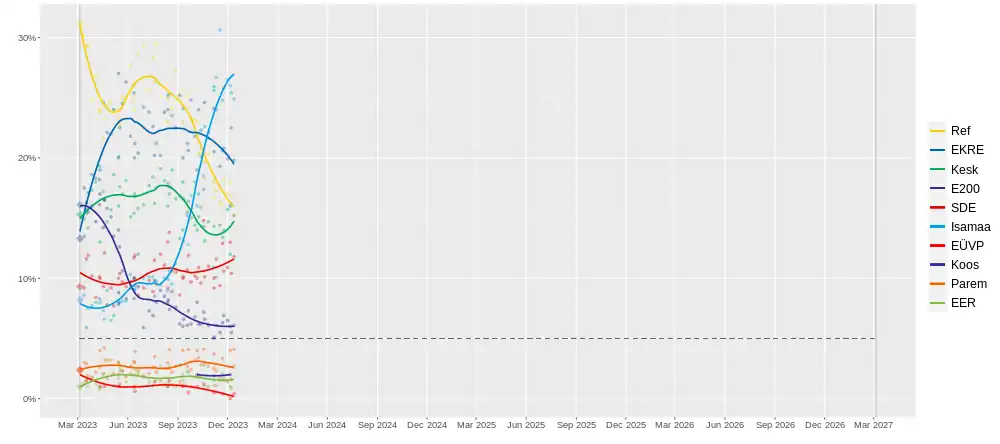| |||||||||||||||||||||||||||||||||||||
All 101 seats in the Riigikogu 51 seats needed for a majority | |||||||||||||||||||||||||||||||||||||
|---|---|---|---|---|---|---|---|---|---|---|---|---|---|---|---|---|---|---|---|---|---|---|---|---|---|---|---|---|---|---|---|---|---|---|---|---|---|
| Opinion polls | |||||||||||||||||||||||||||||||||||||
| |||||||||||||||||||||||||||||||||||||
 Electoral districts | |||||||||||||||||||||||||||||||||||||
| |||||||||||||||||||||||||||||||||||||
Parliamentary elections will be held in Estonia by 7 March 2027 to elect all 101 members of the Riigikogu. Electoral district reform has been discussed for the next election.[1][2]
Electoral system
The Riigikogu is made up of 101 seats and its representatives are elected by proportional representation in twelve multi-member constituencies.[3] First, seats are to be filled in 12 constituencies of 5 to 16 seats depending on their population, and the remaining seats, known as "compensation seats", are allocated using the d'Hondt method to all parties that exceeded the 5% electoral threshold, to bring the results in terms of seats as close as possible to those of the vote of the population.[4][5] Voters have the possibility of casting a preferential vote for one of the candidates on the list for which they are voting.[4][5] If a candidate collects more preferential votes than the amount of the simple quotient in his constituency, they are declared elected even if the list for which they are candidate for fails to cross the 5% electoral threshold.[4][5]
Seats by electoral district
| # | Electoral district | Seats |
|---|---|---|
| 1 | Haabersti, Põhja-Tallinn and Kristiine districts in Tallinn | 10 |
| 2 | Kesklinn, Lasnamäe and Pirita districts in Tallinn | 13 |
| 3 | Mustamäe and Nõmme districts in Tallinn | 8 |
| 4 | Harju (excluding Tallinn) and Rapla counties | 16 |
| 5 | Hiiu, Lääne and Saare counties | 6 |
| 6 | Lääne-Viru county | 5 |
| 7 | Ida-Viru county | 6 |
| 8 | Järva and Viljandi counties | 7 |
| 9 | Jõgeva and Tartu counties (excluding Tartu) | 7 |
| 10 | City of Tartu | 8 |
| 11 | Võru, Valga and Põlva counties | 8 |
| 12 | Pärnu county | 7 |
| Source: Eesti Rahvusringhääling[6] | ||
Opinion polling

References
- ↑ ERR, Madis Hindre | (3 April 2023). "Valimisringkondadest valimiseani – ees võivad seista suured muutused". ERR (in Estonian). Retrieved 8 November 2023.
- ↑ ERR, Uku Toom | (29 May 2023). "Valimisringkondade muutmiseks tellitakse analüüs". ERR (in Estonian). Retrieved 8 November 2023.
- ↑ "Riigikogu Election Act". Riigi Teataja. 20 January 2015. Archived from the original on 12 September 2020. Retrieved 1 April 2015.
- 1 2 3 "Estonia: Riigikogu (The Estonian Parliament)". Inter-Parliamentary Union Parline. Archived from the original on 8 February 2020. Retrieved 7 February 2023.
- 1 2 3 "Valimised". Eesti.ee (in Estonian). Archived from the original on 7 February 2023. Retrieved 7 February 2023.
- ↑ "Harju- ja Raplamaa saab Ida-Viru arvelt valimistel ühe mandaadi juurde". Eesti Rahvusringhääling (in Estonian). 11 November 2022. Archived from the original on 15 February 2023. Retrieved 8 February 2023.

.jpg.webp)
.jpg.webp)
.jpg.webp)
.jpg.webp)
